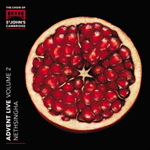One of the methods of development used by contemporary ‘minimalists’ is the use of a motif which is then repeated again and again with a ‘binding’ feature such as a melody leading it into different pitches and tonal areas. Contrast in these pieces is usually provided by the introduction of a different repeated motif in another mood and dynamic. This is the pattern for
I am the day, an unaccompanied work setting a brief Advent text from Revelation chapter 22 describing the promise of the coming of Jesus. It was a Spitalfields Festival commission, first performed in December 1999 by the choir of Trinity College, Cambridge. The key elements are the stillness of the opening bars, marked to be sung ‘with mystery’, and the following scherzo-like music which is ‘dancing and playful’. The second section maintains the melodic element of the first section sung by the basses while the upper voices sing short phrases taken from the Advent hymn
O come, O come Emmanuel. This is highly effective as it acts almost like a distant memory of the hymn—something in the mind which one is trying to remember but, like a folk song learned in the cradle, the whole melody refuses to yield itself fully. The two contrasting elements return before a reflective ending has the trebles and altos gently wafting skywards like rising incense.
from notes by Paul Spicer © 2010
Parmi les méthodes de développement des minimalistes actuels figure l’utilisation d’un motif qui est ensuite répété encore et encore avec un «lien» (une mélodie, par exemple) le conduisant à différentes hauteurs de son et régions tonales. Le contraste vient alors, en général, de ce qu’un autre motif répété est introduit, dans un autre climat, une autre dynamique. Ce modèle est celui d’
I am the day, une œuvre a cappella qui met en musique un petit texte de l’Avent tiré du chapitre 22 de l’Apocalypse et décrivant la promesse de l’avènement de Jésus. Commande du Festival de Spitalfields, cette pièce fut créée en décembre 1999 et chantée pour la première fois par le chœur de Trinity College, Cambridge. Les éléments clés en sont la quiétude des premières mesures, à chanter «avec mystère», et la musique qui vient ensuite, de type scherzo, «dansante et enjouée». Dans la seconde section, l’élément mélodique de la première section est chanté par les basses tandis que les voix supérieures exécutent de brèves phrases empruntées à l’hymne de l’Avent
O come, O come Emmanuel. Violà qui est très efficace: c’est un peu comme un lointain souvenir de l’hymne—une chose qu’on a en tête et qu’on essaye de se rappeler mais, comme avec une chanson populaire apprise au berceau, la mélodie refuse de se livrer complètement. Les deux éléments contrastifs reviennent avant qu’une conclusion pensive ne voie les sopranos et les altos aller doucement vers le ciel, comme l’encens qui s’élève.
extrait des notes rédigées par Paul Spicer © 2010
Français: Hypérion
Eine der von zeitgenössischen „Minimalisten“ verwendeten Entwicklungsmethoden besteht in der beharrlichen Wiederholung eines Motivs, das dann von einem „Bindeglied“ wie zum Beispiel einer Melodie zusammengehalten und in verschiedene Tonhöhen und Tonalbereiche geführt wird. Für den Kontrast in diesen Stücken sorgt normalerweise die Einführung eines weiteren wiederholten Motivs mit anderer Stimmung und Dynamik. Dies ist das Muster für
I am the day, die Vertonung eines Auszugs aus der Offenbarung des Johannes, Kap. 22, für unbegleiteten Chor mit der Verheißung von Jesu Erscheinen. Sie war eine Auftragskomposition für das Spitalfields Festival und wurde erstmals im Dezember 1999 vom Chor des Trinity College, Cambridge aufgeführt. Die Kernelemente sind die Ruhe der einleitenden Takte mit der Vortragsbezeichnung „geheimnisvoll“ und der folgende Scherzo-ähnliche, als „tanzend und verspielt“ bezeichnete Abschnitt, der das melodische Element des ersten Teils in den Bässen übernimmt, während die Oberstimmen kurze Phrasen aus der Adventshymne
O come, O come Emmanuel singen. Dies ist höchst wirkungsvoll, da es fast wie eine ferne, bruchstückhafte Erinnerung an die Hymne fungiert, wie an ein Kinderlied, das sich der vollständigen Erinnerung versagt. Diese beiden kontrastierenden Elemente kehren zurück, bevor sich die Sopran- und Altstimmen wie aufsteigender Weihrauch zu einem besinnlichen Ende emporschwingen.
aus dem Begleittext von Paul Spicer © 2010
Deutsch: Henning Weber


 Advent Live, Vol. 2
Advent Live, Vol. 2
